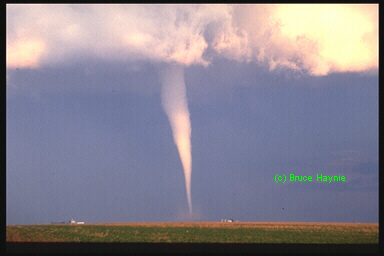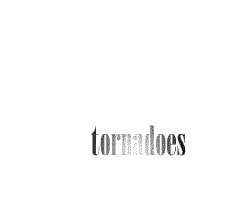




Welcome to the Tornado Project Online! We are a small company that
gathers, compiles, and
makes tornado information available to weather enthusiasts, the meteorological community
and emergency management officials in the form of tornado books, posters, and videos.
There
are many sites with tornado data, so we are giving the subject a little different twist,
with
tornado myths, tornado oddities, personal experiences, tornado chasing, tornado safety,
and
tornadoes in the past as well as more recent tornadoes. We will be adding new pages and
have
some unique ideas planned during the next few months, so come back often and check us out.
You'll be glad you blew in!
The Red Rock Oklahoma Tornado
April 26, 1991
The spring of 1991 was loaded with tornado events and April 26th produced some of the most
violent. It was a busy
chase day. I witnessed an impressive supercell that produced 2 funnels that were almost
tornadoes. The second of
the two funnels came close the ground near the Oklahoma - Kansas border. It later
developed a huge rotating
mesocyclone that produced the Windfield, Kansas tornado. Due to road problems I let the
storm go before the
tornado formed. Dropping south into Oklahoma I intercepted a supercell that produced the
so called Red Rock,
OK tornado shown here. After that I proceeded south and east to observe a large tornado
crossing the Cimarron
Turnpike southeast of Stillwater, OK. Cars drove into the tornado while it crossed the
4-lane causing one fatality.
I later witnessed the same storm produce a huge tornado with a one mile wide damage path
north of Tulsa. It
moved through sections of Skiatook and Collinsville silhouetted by green power line
flashes and continious
lightning. It continued to the northeast as a large wedge until out of sight very near the
town of Oologah where
heavy damage was reported.
Facts about the tornado in the following images: It moved from near Garber, OK to near the
town of Pawhuska,
OK for a path length of 66 miles. A University of Oklahoma chase team used a portable
doppler radar to measure
wind speeds of 286 MPH. This wind speed is usually associated with F-5 tornadoes, but F-4
damage was the worst
found and that's where the tornado was rated. The tornado destroyed a couple of homes and
farms and was
responsible for six injuries. Fortunately it traveled across rural areas with low
population density.